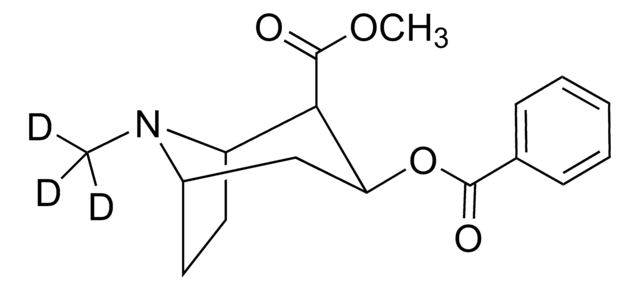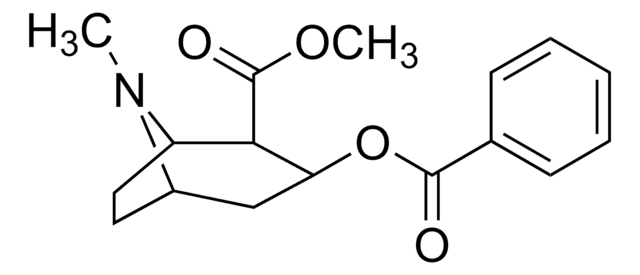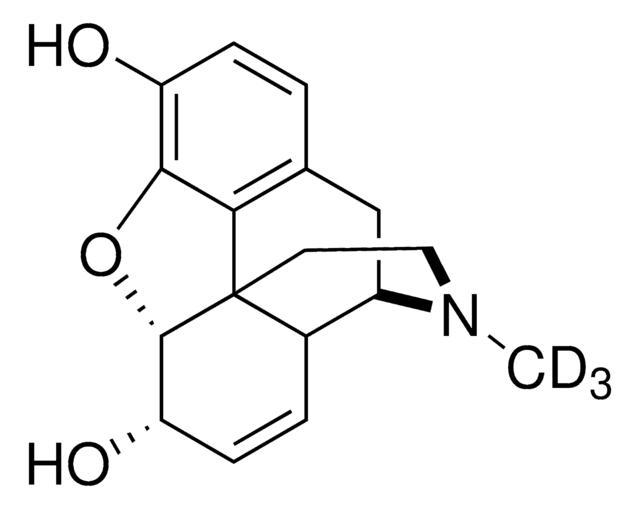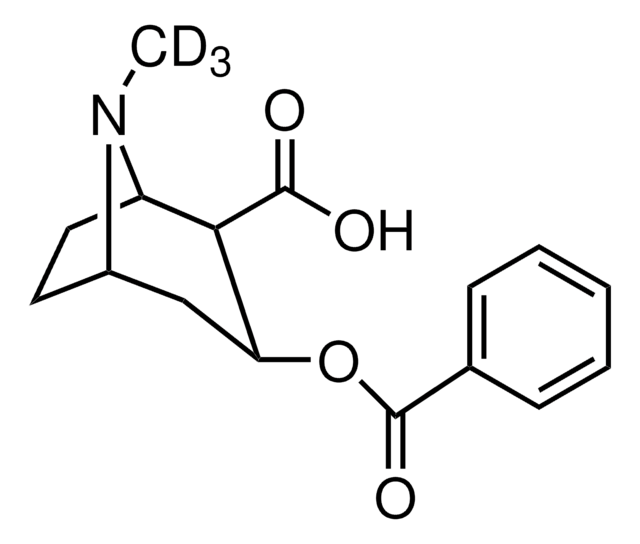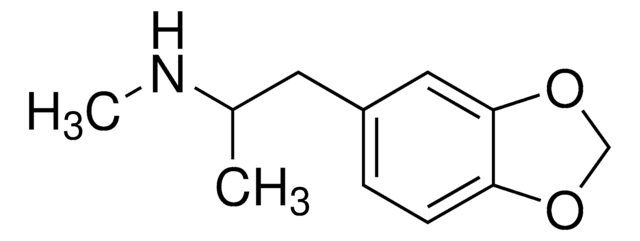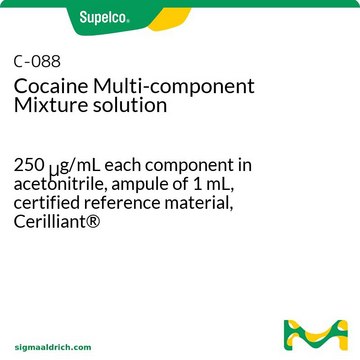B-001
Benzoylecgonine-d3 solution
100 μg/mL in methanol, ampule of 1 mL, certified reference material, Cerilliant®
Synonyme(s) :
Benzoylecgonine-N-methyl-d3 solution
About This Item
Produits recommandés
Qualité
certified reference material
Niveau de qualité
Forme
liquid
Caractéristiques
SNAP-N-SPIKE®, SNAP-N-SHOOT®
Conditionnement
ampule of 1 mL
Fabricant/nom de marque
Cerilliant®
drug control
Narcotic Licence Schedule A (Switzerland); estupefaciente (Spain); Decreto Lei 15/93: Tabela IB (Portugal)
Concentration
100 μg/mL in methanol
Technique(s)
gas chromatography (GC): suitable
liquid chromatography (LC): suitable
Application(s)
forensics and toxicology
Format
single component solution
Changement de masse
M+3
Conditions d'expédition
wet ice
Température de stockage
−20°C
Chaîne SMILES
[2H]C([2H])([2H])N1[C@H]2CC[C@@H]1[C@H]([C@H](C2)OC(=O)c3ccccc3)C(O)=O
InChI
1S/C16H19NO4/c1-17-11-7-8-12(17)14(15(18)19)13(9-11)21-16(20)10-5-3-2-4-6-10/h2-6,11-14H,7-9H2,1H3,(H,18,19)/t11-,12+,13-,14+/m0/s1/i1D3
Clé InChI
GVGYEFKIHJTNQZ-GZBWLTEMSA-N
Vous recherchez des produits similaires ? Visite Guide de comparaison des produits
Description générale
Application
- Mass Spectrometry Internal Standard: Benzoylecgonine-d₃ is utilized as a robust internal standard in mass spectrometry to enhance the accuracy and precision of quantitative analysis of cocaine metabolites in clinical toxicology studies, providing crucial data for forensic and clinical applications (Handley et al., 2019).
- Forensic Toxicology Research: The application of Benzoylecgonine-d₃ in gas chromatography-mass spectrometry (GC-MS) underscores its value in the forensic analysis of cocaine and its metabolites in biological samples, offering reliable quantification essential for legal and medical investigations (Fleming et al., 2010).
- LC-MS/MS Quantitative Analysis: Benzoylecgonine-d₃ serves as a critical component in developing validated LC-MS/MS methodologies for drug testing, ensuring the traceability and reproducibility required in doping control and therapeutic drug monitoring (Lin et al., 2001).
- Pharmacokinetic Studies: The use of stable isotope-labeled Benzoylecgonine-d₃ enables detailed pharmacokinetic studies, helping to understand the metabolism of cocaine and assess the impact of various physiological and pathological conditions on drug metabolism (Lin et al., 2001).
- Drug Metabolism Analysis: In forensic science, Benzoylecgonine-d₃ is crucial for developing sensitive and selective analytical methods for detecting and quantifying cocaine use, supporting both clinical diagnostics and legal proceedings (Hall et al., 1999).
Informations légales
Produit(s) apparenté(s)
Mention d'avertissement
Danger
Mentions de danger
Conseils de prudence
Classification des risques
Acute Tox. 3 Dermal - Acute Tox. 3 Inhalation - Acute Tox. 3 Oral - Flam. Liq. 2 - STOT SE 1
Organes cibles
Eyes,Central nervous system
Code de la classe de stockage
3 - Flammable liquids
Classe de danger pour l'eau (WGK)
WGK 2
Point d'éclair (°F)
49.5 °F - closed cup
Point d'éclair (°C)
9.7 °C - closed cup
Certificats d'analyse (COA)
Recherchez un Certificats d'analyse (COA) en saisissant le numéro de lot du produit. Les numéros de lot figurent sur l'étiquette du produit après les mots "Lot" ou "Batch".
Déjà en possession de ce produit ?
Retrouvez la documentation relative aux produits que vous avez récemment achetés dans la Bibliothèque de documents.
Les clients ont également consulté
Notre équipe de scientifiques dispose d'une expérience dans tous les secteurs de la recherche, notamment en sciences de la vie, science des matériaux, synthèse chimique, chromatographie, analyse et dans de nombreux autres domaines..
Contacter notre Service technique
